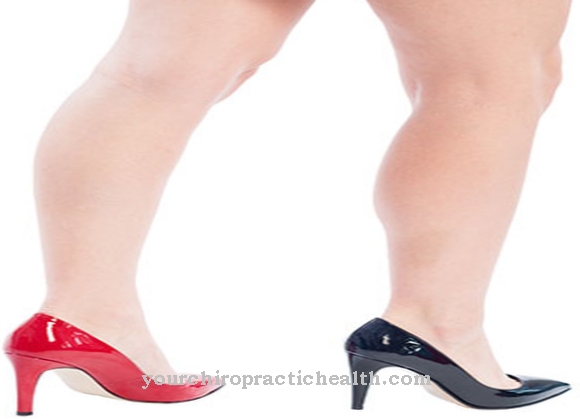The Silver-Russell syndrome (RSR) represents a very rare syndrome, which is already characterized by prenatal growth disorders with the development of short stature. So far, only about 400 cases of the disease have been documented. The appearance is very variable and suggests that it is not a uniform disease.
What is Silver Russell Syndrome?

© ustas - stock.adobe.com
The Silver-Russell syndrome is characterized by a intrauterine short stature out. Intrauterine means that the short stature develops in the womb. The child's growth is stunted for reasons that are not yet exactly known. The disease was examined more closely in 1953 and 1954 by the Englishman Henry Russel and the American Alexander Silver.
In English-speaking countries, the syndrome is also called Russel-Silver Syndrome (RSS) designated. Henry Russel and Alexander Silver were mainly interested in the causes of this disease. In doing so, they were able to determine that there is no uniform disease, but rather a complex of symptoms that are genetically determined but are based on different genetic defects.
The main feature of this disease is intrauterine short stature with malnutrition. On the basis of the documented cases, the two doctors were able to demonstrate sporadic and familial forms of the disease. From this they concluded at that time that there was a genetic disease.
causes
According to recent studies, different causes can be assumed for the development of Silver-Russell syndrome. However, common to all forms is the genetic basis of the disease. A so-called maternal uniparental disomy 7 (UPD (7) mat) was discovered in 15 percent of all those affected. Two copies of the maternal chromosome no. 7 were inherited from each patient.
The corresponding paternal chromosome is missing or damaged. This situation speaks for what is known as imprinting. Only one maternal chromosome 7 is active here. However, it is not yet known which mechanisms lead to the short stature. In addition to this double maternal chromosome 7, another form of Silver-Russell syndrome is 40 percent attributed to insufficient methylation of chromosome 11.
The paternal allele H19-DMR in 11p15 is affected. The insufficiently methylated allele encodes an inoperable RNA. Usually the paternal H19 gene is well methylated and the corresponding maternal allele is not. When the DMR1 region of the paternal allele is methylated, the growth factor IGF2 is produced. However, if the paternal allele is poorly methylated, this factor is no longer sufficiently generated.
In addition to the two main causes of Silver-Russell syndrome shown, other structural chromosomal changes were found. Lengthening in the short arm of chromosome 7 or shortening in the long arm of chromosome 17 were found.
Symptoms, ailments & signs
Silver Russell syndrome is characterized by a wide variety of symptoms. The main symptom is the intrauterine short stature with malnutrition. The child usually weighs less than two kilograms at birth. The head is relatively large in relation to the body. The forehead is often high and bulging. The face is triangular and has deep set ears set back.
In addition, a pointed chin, creased eyelids and a no mouth with drooping corners of the mouth characterize those suffering from Silver Russell Syndrome. The misaligned teeth are noticeable. The skin is thin and contains white to brownish spots. There are misalignments of fingers and toes. Bone maturation is significantly delayed, which explains the reduced growth in length. The growth is uneven.
The adult size is below average in two thirds of the sick. However, one third is normal in size. The weight remains below average. Other symptoms such as cleft palate, very high voice, hearing loss, hypoglycaemia or keratoconus may occur. Overall, it should be noted that not all those affected develop all symptoms. The mental performance is not restricted.
Diagnosis & course of disease
The diagnosis is made difficult by the development of the various symptoms. If certain key symptoms are present, it can be assumed that it is the Silver-Russell syndrome. However, it is not yet known which form of the disease is present.
To do this, the degree of methylation of allele H19-DMR of the 11th chromosome is first determined. If this is too low, the patient belongs to the 40 percent of those affected with this defect. If it is not confirmed, a fundamental examination of the genetic material must be carried out.
Complications
Silver-Russell syndrome can lead to many different complaints and complications, all of which significantly reduce and limit the quality of life of the person concerned. As a rule, this results in a short stature and various malformations. The head of those affected is excessively large.
This complaint can lead to bullying or teasing, especially in children or adolescents, and thus to depression and other psychological complaints. The face is also affected by the malformations, so that the aesthetics are significantly reduced. Furthermore, the Silver-Russell syndrome leads to misalignment of the teeth and discomfort to the bones.
These can break more easily, so that patients are more likely to suffer from injuries or fractures. In the further course of the disease, hearing and visual problems usually develop. Mental retardation can also occur and make everyday life difficult for the person concerned. They are often dependent on the help of other people.
A direct and causal treatment of the Silver-Russell syndrome is not possible. However, the individual malformations can be treated. In most cases, the life expectancy of those affected is not limited or reduced by the syndrome.
When should you go to the doctor?
Silver Russell syndrome usually always requires medical treatment. This disease cannot heal itself, so that the patient is always dependent on treatment by a doctor. Since Silver-Russell syndrome is a hereditary disease, genetic counseling should also be carried out if you want to have children to prevent further complications and the inheritance of the syndrome.
A doctor should be consulted if the person concerned suffers from various malformations on the body. This results in an oversized head and usually a significant underweight immediately after birth. The Silver-Russell-Syndrome can also be recognized by severe misalignments of the teeth, whereby most of those affected also suffer from a hearing loss or from a cleft palate.
In some cases, short stature points to Silver-Russell syndrome and must be examined by a doctor. The first diagnosis of the syndrome is usually made in the hospital right after the birth. With Silver-Russell syndrome, those affected are dependent on lifelong therapy in order not to reduce life expectancy. Since the syndrome can also lead to psychological complaints, psychological treatment should also be carried out.
Therapy & Treatment
A causal treatment of the disease is not possible due to the genetic basis of Silver-Russell syndrome. The main aim is to stimulate growth by administering growth hormones. In some cases this works very well. In this way, the growth in length could in some cases be significantly increased. In other sufferers, this therapy sometimes shows little or no success.
Since many sick people also often suffer from hypoglycaemia, everything should be done to avoid hypoglycemia. Otherwise, people with SRS are usually not restricted in their quality of life. With the multitude of possible symptoms, however, certain restrictions can occur. In addition to hypoglycemia, possible keratoconus could lead to visual impairment.
Here the cornea of the eye becomes curved in a cone shape and sometimes requires constant adjustment of the glasses or contact lenses. At If a cleft palate develops, corrective surgery must be performed.
prevention
Prophylaxis for Silver-Russell syndrome is very difficult because the disease is often sporadic. In familial cases, a human genetic test should be carried out to determine the genetic status. The risk for the offspring should then be discussed as part of a human genetic counseling.
Aftercare
In most cases, there are no special follow-up options available to those affected with Silver-Russell syndrome. For this reason, the person affected should ideally contact a doctor at an early stage and thus initiate treatment so that there are no complications or other complaints in the further course.
Since Silver-Russell syndrome is a hereditary disease, it can usually not be completely cured. Therefore, if you want to have children, genetic counseling and testing should definitely be carried out so that this disease cannot recur. Most of those affected depend on the help and support of their own families in their everyday lives.
This can make everyday life much easier for those affected, which can also prevent depression and other psychological upsets. In many cases, surgical interventions are also necessary to alleviate the symptoms. After such an operation, the person affected should rest and take care of their body. You should refrain from exertion or from stressful and physical activities. In some cases, Silver-Russell syndrome will reduce the life expectancy of the person affected, but no general prediction is possible.
You can do that yourself
A pregnant woman is well advised to take part in all of the preventive and check-up examinations offered during pregnancy. The health status of the offspring is checked and documented in various tests and imaging procedures. In the event of irregularities, it is already possible to find out in this phase which faults may be present. This gives the parents-to-be the opportunity to react to the situation at an early stage and to take appropriate decisions and take precautions.
In everyday dealing with the disease, a stable self-confidence is necessary. The social environment should be informed about the disorder and the corresponding complaints. This helps to prevent misunderstandings or conflicts. Since the mental performance of the patient is limited, support measures should be initiated at an early stage. It is helpful if training and exercises to improve the situation are also carried out independently outside of the therapy. Even though this does not cure the patient, the symptoms are alleviated. Coping with everyday life is made easier and well-being increased.
Since there is an increased risk of injuries or broken bones in the sick, this must be taken into account when moving around and performing sports exercises. Leisure activities must also be tailored to the requirements of the organism.

























.jpg)


